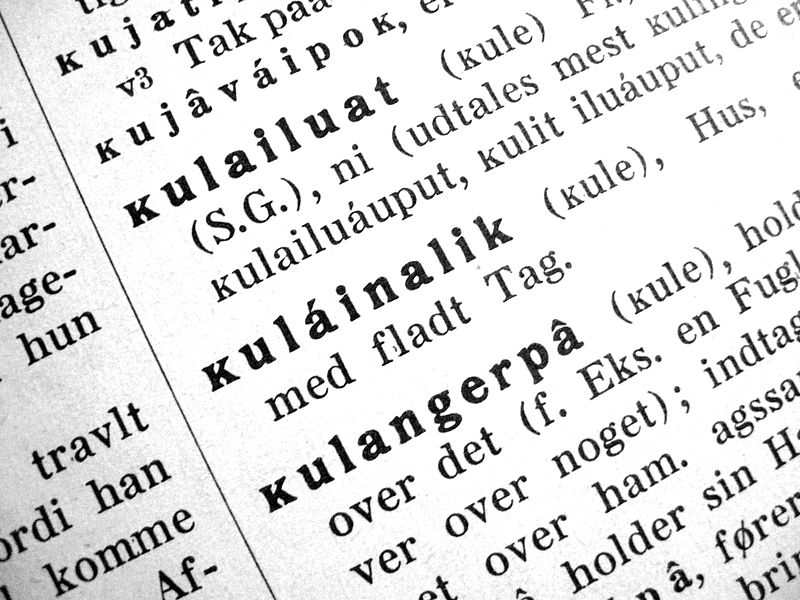
Greenlandic’s Steady Extinction
By Keerthana Annamaneni
[divider]
[dropcap]I[/dropcap]n Greenland, people don’t rely on Google maps or navigation systems to find their way around. Instead Greenland’s Inuit use how the wind feels against their bodies to pinpoint their distance from the sea. Each of these nuanced winds has a specific name in Greenlandic: for example, isersarneq, which loosely means “a wind in the fjord that comes in from the sea, and it can be hard to get home, but once you get out of the fjord, it’s nice weather.” For the Inuit, natural experiences are inextricably linked to their language.
However, rampant climate change has affected few places as severely as Greenland, changing wind patterns and the Inuit’s ability to recognize the winds they face. And this climate change is mirrored by an undeniable linguistic shift in Greenlandic; the Inuit’s terms for winds are being used with less and less regularity.
Greenlandic belongs to the Eskimo family of languages and is ‘polysynthetic’: its words are formed with a root, multiple affixes, and a suffix. Greenlandic words can thus correspond to entire sentences in other languages. For example, the Greenlandic word for ‘computer’ is ‘qarasaasiaq’ in Greenlandic, which directly translated means ‘artificial brain.’ Similarly, the word for ‘potato’ is ‘naatsiiat,’ which directly translated, means ‘something for which one waits for a long time to grow up’. The complex meanings of these individual words is characteristic of Greenlandic.
Beyond this, we don’t know much about Greenlandic, a language spoken by 57,000 indigenous people in Greenland, since the language is spoken by so few people, has rarely been studied by linguists, and is primarily spoken in isolated communities in Greenland. “There’s a lot we don’t know about how it works, or how the mind works when it does this,” Lenore Grenoble, a linguist at the University of Chicago, says. But as the language starts to devolve with climate change, linguists can’t help but worry that the language will soon go extinct before we can piece it together. At the very least, the language may lose an integral part of its identity, its inextricable link to the natural world, before we can fully understand how this part of Greenlandic’s identity influences how speakers think and interact with the natural world.
And this conflict only mirrors a larger global phenomenon. From a linguistic perspective, we’ve lived past the peak of verbal diversity on Earth. Linguists predict that half of the world’s 7,000 languages will have disappeared within the next decade.
Often, people learn languages spread by colonial powers or languages that might make way for more economic or social mobility. Since indigenous languages and languages on the brink of extinction may not offer economic incentives for speakers, these languages are lost in a trade off between cultural and economic incentives,
Most recently, however, languages have found a new threat: climate change. As rising sea levels threaten pockets of people all over the world, “climate change refugees” find themselves leaving their communities for foreign lands, leaving their cultures–and languages–behind. Their native tongues will have to compete to survive in new environments, and the ensuing conflict can add to the extinction process.
Of course, intentional efforts on an institutional level can attempt to reverse these trends. Greenland’s government has been replacing Danish names for locations with Inuit Greenlandic titles; they have translated written documents into Greenlandic; and perhaps most importantly, they have ensured that Greenlandic is being spoken and taught in public schools. In 2013, Greenland’s language committee, which deliberates on new, official words, importantly approved the Greenlandic term for climate, silap pissusia, and climate change, silap pissusiata allanngornera.
However, to ensure that Greenlandic survives for future generations, perhaps nominal institutional changes are not enough–or will not function quickly enough. If Greenlandic becomes extinct, we will lose a way of thinking about the natural world that can never truly be reestablished. As Katti Frederikson, the head of the language committee put it in an interview with Grist, “If we lose our language, lots of stories will be lost, and lots of the traditional knowledge about nature, climate, medicine, and landscape. And of course the way we think, the way we act, will be lost. So what I’m trying to say is that by the time people stop speaking [Greenlandic], we’ll have lost Greenlanders.”
But before serious efforts to revitalize the language take place, serious questions remain: for example, whose responsibility should reviving dying languages like Greenlandic be? Who will benefit most from revitalizing dying languages–and dying cultures–and who should bare the brunt of the cost? The global north, which is responsible for climate change? Or the global south, which has an inextricable link to the cultures being lost? And is there truly a tangible benefit from keeping these cultures alive, rather than cataloging them in a museum, somewhere? It isn’t a given that every culture and linguistic tradition adds to the human experience. Perhaps some languages should be left to die a natural death, lending way to linguistic homogeneity and perhaps, easier global communication, or perhaps every language offers a unique perspective into the way communities see their worlds and add to the rich cultural fabric of our world.
[hr]
Keerthana “Keera” Annamaneni is a freshman in Timothy Dwight college. Contact her at keerthana.annamaneni@yale.edu.